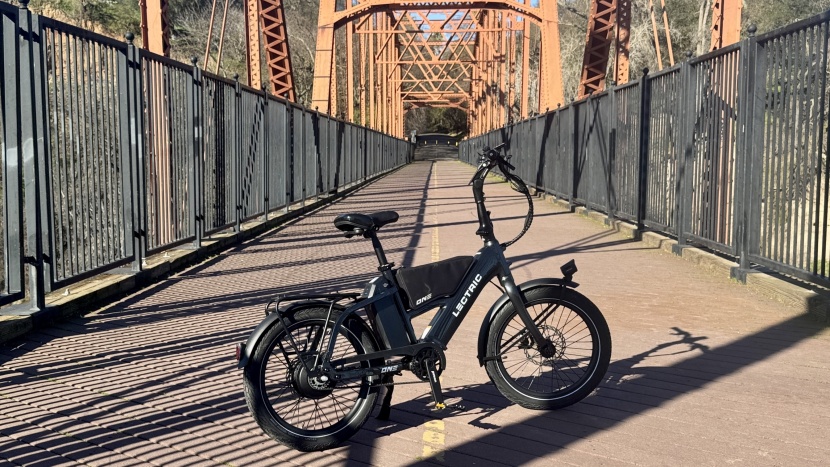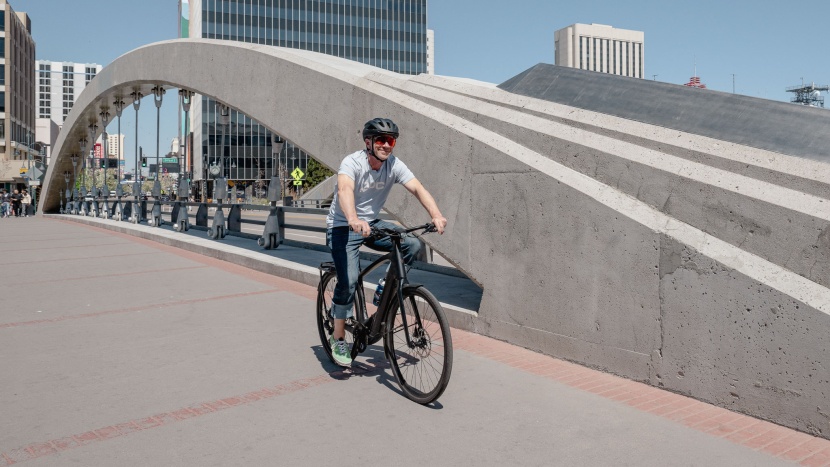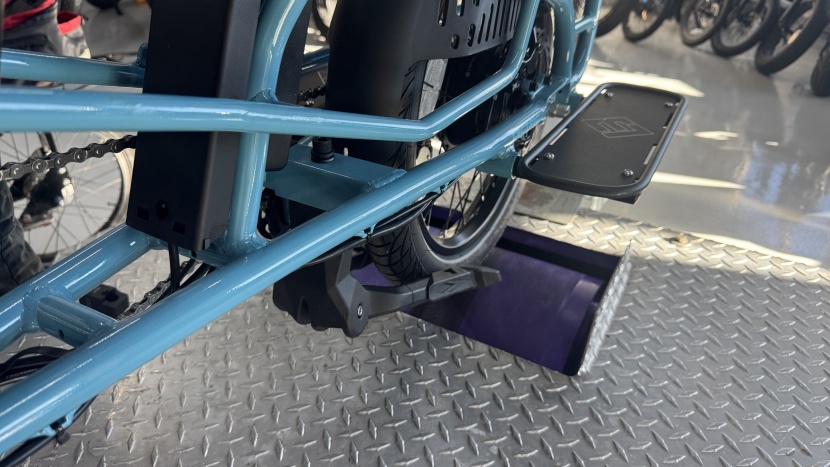To compare the e-bikes in this review, we subjected each model to the same rigorous testing process. Before testing, we identified the most critical performance attributes of electric bikes to establish our rating metrics. For each metric, we determined the best way to test and analyze the performance of each model to compare the bikes to one another. During testing, we took detailed notes, and after testing was completed, we rated each model based on cumulative scores and determined our award winners.
Ride
To assess the ride quality of the electric bikes in this review, we rode each bike for more than a month, gaining a feel for the quality of the ride and how the component choices affect the bike's performance. We perform a variety of handling-specific tests to determine how the bikes compare against one another. During our range test, our test rider rides non-stop for up to three hours on a test course with gently rolling hills and a mixture of hard-packed surfaces like pavement, gravel, and dirt. The extended length of the range test also allowed us to analyze the long-term comfort of each bike's geometry and touchpoints, such as the saddle and grips.
Every bike is run through a series of handling tests in a more controlled environment. Using our own closed parking lot, we set up cones and rode each bike in figure eights around them to assess low-speed handling and performance in tight turns. We brought each bike up to its top pedal-assisted speed and made large, sweeping turns. We tested braking performance by measuring the distance required to bring the bike from its top speed to a complete stop. We also rode each bike down a sustained hill to test the straight-line high-speed stability.
In addition to our handling tests, we also analyzed the performance of each bike's components, including the wheels, tires, and drivetrain. Additional features like lights, racks, and fenders were also considered based on their impact on the user experience.
Range
The range of an electric bike refers to the distance it can travel on a single charge of its battery. Different-sized batteries, motor power, rider weight, rider pedaling input, and terrain all contribute to determining how far a bike will travel before its battery is depleted. Due to these factors and variables, accurately testing and comparing the range of electric bicycles can be a challenge. To create a level playing field and minimize external variables as much as possible, we conduct all our range tests on the same course with the same weight rider in similar weather conditions. We set the bikes to their highest power setting and load our test rider to an even 180 pounds before each test. With the tires at the maximum recommended pressure, we set off using only the throttle, eliminating the variable of rider input to determine the absolute low end of each bike's range potential. These bikes can be ridden much further when using their pedal assist modes with a pedaling rider.
For testing accuracy, we use the same Garmin Edge 840 GPS-enabled cycling computer to track and log each test ride for consistency. For redundancy, we also track each ride with Ride with GPS, Apple Fitness, and Strava. These devices track our distance, elevation gain, time, average speed, and maximum speed. We then compiled all of our data for more detailed analysis.
Power
Electric power is the primary feature that distinguishes an e-bike from its non-electric counterparts. The power of a bike varies primarily based on the size and wattage of the motor and its electrical architecture. It stands to reason that a 750W (1HP) motor will be more powerful than a 250W motor, or a 52V system will supply more power than a 36V system. That said, we were also interested in the quality and consistency of the power output. To test the models' power output in this test, we performed several tests using the pedal assist and the throttle when applicable.
We test each bike's top speed (and speedometer accuracy) on flat ground by observing the speedometer and comparing it with a Garmin 840 and double-checking with a GPS app like Strava. We test acceleration by measuring the time it takes for the bike to reach its full speed from a complete stop on flat ground. We use a closed road with a steep (9%) incline to measure each bike's hill-climbing prowess and record the speed from flat ground to the apex of the hill.
Specific to pedal assist, we first examined the number of pedal assist modes each bike offered and the level of support provided in each setting. The top speed was determined by placing each bike in its highest support mode while pedaling at a high intensity and noting the speed at which the motor stopped assisting. In theory, this should be the same across the board, but we've found quite a few strays. The quality of the pedal assistance was also analyzed by shifting through all modes and pedaling in various gears (high vs. low) to see how the assistance was delivered. Some systems utilize advanced torque sensors that adjust support based on the rider's pedal effort. In contrast, others employ cadence sensors and deliver support proportional to the speed at which the cranks are turning.
Beyond experiential testing, we utilize a modified motorcycle dynamometer to precisely determine the exact power and torque delivered to the ground. We measure peak power in watts and graph it against peak torque in Nm. Peak power is often significantly higher than the nominal (or rated) power of the motor. By using a dynamometer, we push beyond the claims and feel of the bike and have hard data to compare.
Interface
The interface of an electric bike refers to all the ways the user interacts with it, including the controls, display, and charging of the battery. Each bike has a unique set of controls to shift through the various pedal assist modes, and their layout, ergonomics, and user-friendliness vary significantly. During our range testing, handling tests, and general use around town, we examined the quality of the controls of each model by using them frequently. The display is a crucial feature that shows the rider important information relevant to their current ride. Like the controls, the displays vary wildly from large LCD screens to small LED lights. Some advanced displays offer information like elapsed time, current speed, pedal-assist setting, remaining battery life, and more at a glance. Other displays are only capable of showing you the basics, like the current pedal assist setting and the battery's state of charge. Further differentiating models, some have apps with digital dashboards that provide a trove of data and even turn-by-turn navigation. The differences are quite obvious, and we tend to prefer easy-to-read LCD screens that are well placed and easy to see at a glance while riding.
The charging process for batteries is generally relatively standard across the different models we tested. Each bike comes with its own charger, which typically features a plug compatible with the charging port on the battery. Batteries can be charged on the bike, and in most cases, the battery can also be removed for charging away from the bike and security purposes. During testing, we had the opportunity to charge each battery multiple times, paying close attention to the location of the charging port, the charging port cover, and the overall user-friendliness of the charging process. We also noted how easily the battery could be removed, whether for charging or theft prevention. We also time the charging of the battery to measure how long a fully depleted battery pack takes to charge completely. Some manufacturers are offering faster charging, which may be more convenient but takes a toll on the battery's life span.
Assembly
Buying a bike from a brick-and-mortar retailer typically ensures that a qualified bike mechanic will assemble it for you. When buying a bike online, it will typically be shipped directly to the consumer with most, but not all, of the assembly completed. Consumer-direct brands typically ship their bikes around 85% assembled, with just a few simple steps remaining to complete the assembly and make them ready to ride. The consumer can often opt to pay for assembly at a local shop or by a mobile bike mechanic.
Most of the electric bikes we tested were shipped directly to us from the manufacturer or a third-party seller. Upon receiving each bike, we removed it from its packaging and assembled it ourselves in the GearLab garage like an everyday consumer. We made notes if there were discrepancies in the directions or if the included tools were insufficient. During the assembly process, we tracked the steps required to transform each bike from packaging to a ready-to-ride state, as well as the time it took to complete them. We also thoroughly examined the printed instructions and referenced any online resources to ensure clarity and usefulness during the assembly process. We capture all of our assemblies with a time-lapse camera and record the time it takes from the box opening until we can ride away on the bike.




